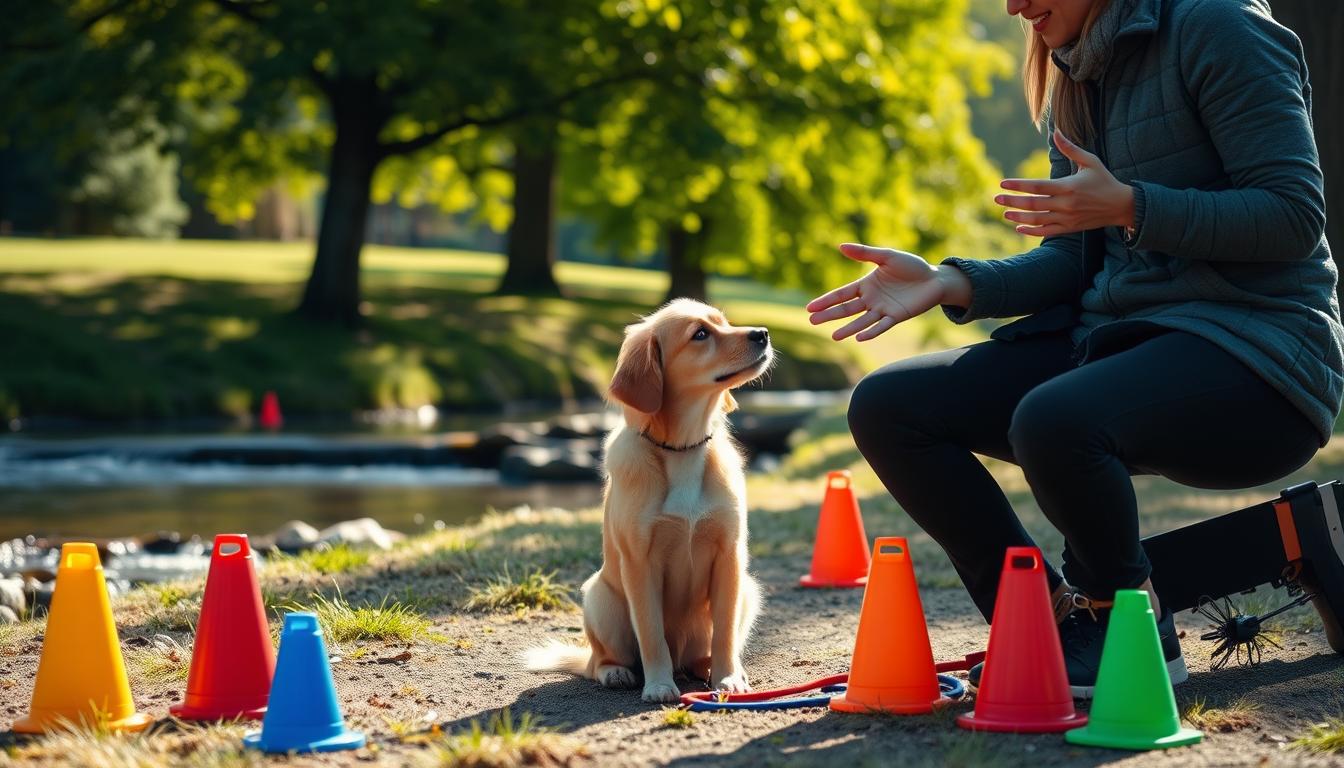Imagine coming home after a long day to find your favorite shoes chewed up. This is a common problem for many dog owners. It shows the challenges of dealing with bad dog behavior.
You might wonder why your dog is acting out. Maybe they bark too much, jump on guests, or dig in the garden. It’s important to know how to stop bad dog behavior. This is not just for a peaceful home but also for a strong bond with your dog.
In this article, you’ll learn proven training techniques to solve these problems. By understanding why your dog behaves badly and using the right training, you can make your home calm again. This will lead to a happier, healthier relationship with your dog.
Key Takeaways
- Recognizing common signs of bad dog behavior is the first step toward resolution.
- Understanding the root causes helps tailor your training approach.
- Consistency is key in implementing effective training techniques.
- Positive reinforcement is a powerful method for encouraging good behavior.
- Establishing a solid obedience training foundation can prevent future issues.
- Awareness of behavior triggers allows for better management of distractions.
- Engaging in training sessions keep your dog motivated and eager to learn.
Understanding Bad Dog Behavior
Many dog owners face challenges with bad behavior. This can lead to frustration and misunderstandings. It’s important to understand and recognize bad dog behavior to find effective training strategies.
Common Signs of Bad Behavior
Watching your dog’s actions can give you clues about their behavior. Here are some common signs to look out for:
- Excessive barking: This can mean boredom, anxiety, or a need for attention.
- Chewing on furniture: Destructive chewing often comes from stress or not having the right chew toys.
- Aggression towards people or other dogs: This might be due to fear or not being socialized enough.
- Jumping up on people: While it looks like excitement, it can be annoying and disruptive.
- Ignoring commands: If a dog doesn’t listen, it might be confused or not trained well.
Identify the Root Causes
To understand bad dog behavior, we need to look deeper. Common reasons include:
- Anxiety: Dogs may act out due to separation anxiety or fear of loud noises.
- Lack of socialization: Not being exposed to different places and people can cause fear and aggression.
- Past trauma: Abuse or neglect can lead to aggression or withdrawal.
- Insufficient exercise: Not enough physical activity can cause boredom and lead to chewing and digging.
How to Stop Bad Dog Behavior: Proven Training Techniques
Training your dog needs a careful plan. It builds a strong bond between you and your pet. To stop bad dog behavior, use proven techniques that help you both have positive times together.
Being consistent and using positive training is key. This way, your dog learns good habits and stops bad ones.
Importance of Consistency in Training
Being consistent in dog training sets clear rules for your pet. Dogs do best when they know what to do. Use the same commands in every training session.
Make sure everyone in your home uses the same commands. This regular practice helps fix bad dog behavior.
Utilizing Positive Reinforcement Techniques
Positive reinforcement training rewards good behavior. Use treats, praise, or playtime as rewards. When your dog acts well, say thank you right away.
This method makes your dog want to please you. It also makes your bond stronger.

Using these methods creates a good learning space. With consistency and positive training, your dog’s behavior will get better. You’ll enjoy a happy life together.
Establishing Effective Obedience Training
Starting obedience training is easy with basic commands. These commands help your dog behave better and make your bond stronger. Knowing these commands is key for more complex training and better interactions.
Basic Commands to Start With
Learn the basic commands first. They are important for guiding your dog’s actions. Here are some key ones:
- Sit: Makes your dog sit and stay still.
- Stay: Tells your dog to stay where they are until you say it’s okay to move.
- Come: Calls your dog to you, keeping them safe in public.
- Down: Helps your dog calm down by lying down.
Using these commands in your training makes your dog more disciplined. It also makes training fun for both of you.
Creating a Training Schedule
Having a regular training schedule is crucial. It helps your dog learn better and know what to expect. Here are some dog training tips for a good schedule:
- Short Sessions: Train for 5-10 minutes several times a day. This keeps your dog focused and avoids distractions.
- Set Specific Days: Pick certain days for each command. This helps you master each one before moving on.
- Incorporate Breaks: Give your dog lots of breaks. This keeps them interested and avoids getting frustrated.
By using this structured plan, you’ll get the most out of your training. It sets the stage for more advanced commands later. This careful approach will improve your dog’s behavior over time.

Implementing Canine Behavior Modification Strategies
Managing your dog’s behavior starts with finding out what makes them act out. Knowing what triggers bad behavior is key. This could be other animals, loud noises, or new places.
By knowing these triggers, you can take steps to stop bad reactions. This makes your dog’s life better.
Understanding Behavior Triggers
Knowing what makes your dog react is the first step in training. Common things that might upset them include:
- Other pets or animals in the vicinity
- Sudden loud sounds like fireworks or thunderstorms
- Unfamiliar people or environments
- Situations that provoke anxiety or fear
After finding out what triggers your dog, you can make their world calmer. This helps them feel more at ease.
Using Redirection Techniques
Redirection is a great way to change your dog’s behavior. If your dog starts acting badly, try to change their focus. You can do this by:
- Offering a toy when your dog displays aggression toward another pet
- Engaging your dog in a short training exercise during moments of distraction
- Leading them towards a calmer area when they become overly excited
Using these methods helps control your dog’s behavior. It makes your home a happier place for both of you.
Dog Training Tips for Everyday Situations
Training your dog in everyday places can be fun and hard. Finding good dog training tips helps a lot. It’s especially useful for handling distractions and keeping training fun. A good plan helps your dog learn better and makes your bond stronger.
Managing Distractions During Training
Many things can distract your dog, at home or out. Here are ways to keep them focused:
- Identify Distraction Triggers: See what distracts your dog and practice those things during training.
- Teach “Leave It” Command: This command helps your dog ignore distractions and pay attention to you.
- Training in Controlled Environments: Start in a quiet place, then add distractions little by little to help your dog stay focused.
Keeping Training Sessions Engaging
To keep your dog interested, mix up your training. Here are some tips:
- Incorporate Games: Use games like fetch or hide-and-seek to make learning fun and keep your dog excited.
- Vary the Training Environment: Change where you train to keep things interesting and prevent boredom.
- Use Toys as Rewards: Having their favorite toy can make your dog want to learn more and stay focused.
These tips make handling distractions easier and keep training fun. Use them to create a great place for your dog to learn and grow.
Conclusion
Understanding bad dog behavior is the first step in effective dog training. We talked about how to spot bad behavior and why it happens. We also shared ways to use positive methods to fix it.
These methods are real and can help you and your dog get closer. They make your bond stronger.
Changing bad dog behavior takes time. You need patience, persistence, and dedication. Keep training and use the right techniques to fix problems.
This way, you and your pet will have a better relationship. It will be more fun and respectful.
The main goal is to make your home happier for you and your dog. Use these training tips to improve your dog’s behavior. The benefits are worth the effort.













